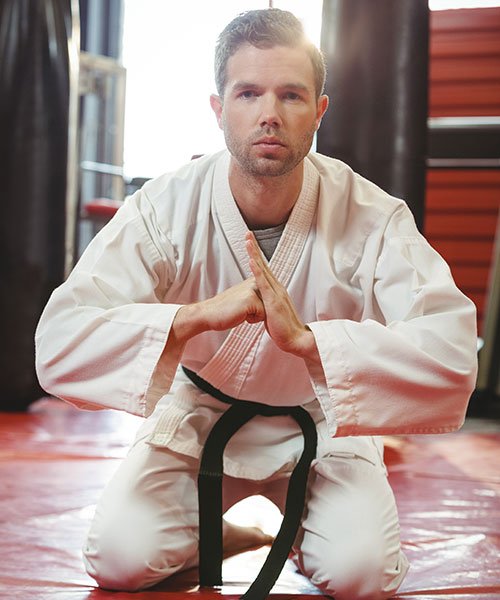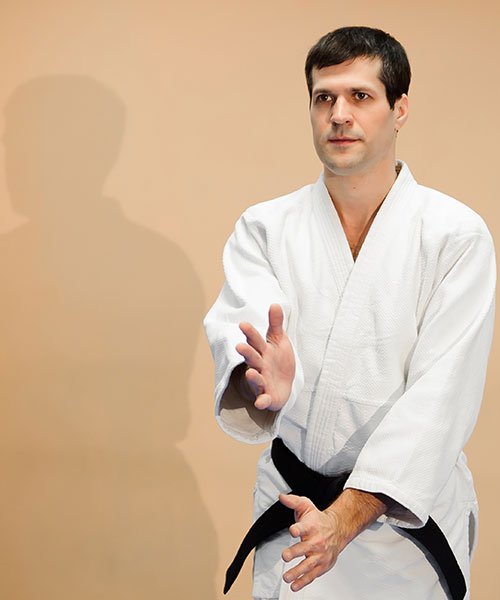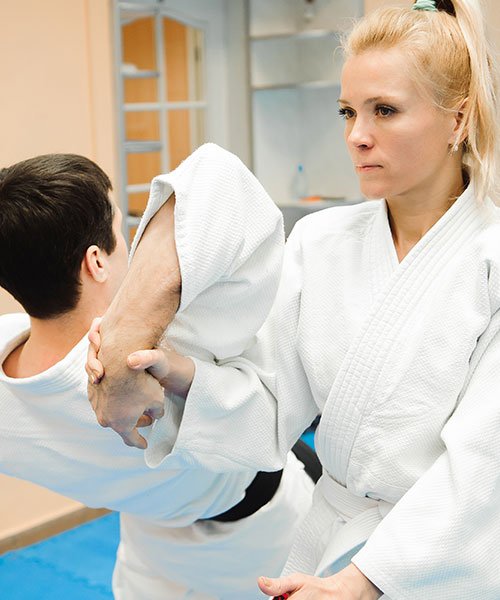We bet you are all ready to learn the ultimate technique to improve your core strength and show your physical capability to others. Aren’t you? Well, you have come to the right place. We bring you Karate in its best form, its core values and methods imparted from the best in the field. But, what we believe in and teach is not the commercial Karate that you will see in other places. This is because we don’t see Karate as just a martial art that is used for mere fighting. Karate fighting is the development of your complete form as a human being.
So, what exactly did we mean by that? You might be confused because what you have perceived as the sport may be like Olympic karate or karate fighting in movies is where one person with all his quick movements and straight moves just kicks the life out of another person that he falls on the floor writhing in pain. Does it look appealing to anyone? No. Is it right to harm a person without any concrete reason such as an unavoidable situation like saving your own life against an imminent danger? Well, this is exactly what Karate is based on.
Yes, you heard that right. The ancient martial art says that Karate kicking is not the way to deal with your problems but is the way for you to discover yourself. It is your inner awakening that Karate offers. Sort of a spiritual transformation! Karate is the way you challenge your physical as well your intellectual capability. It aims at converting your whole body through the successful control of your mind. And the ancient texts about Karate say that your mind is what defines you. The rigorous training that Karate makes you undergo is therefore how you go through hardship while your mind becomes stronger, the will and your perseverance to complete the training make you a better person determined and robust.
However, there are certain etiquettes that you need to follow if you want to learn the art:- Standing Bow:
- Yes, karate requires you to stand in a certain posture. With feet pointing slightly outwards ‘like a V’, you need to stand with heels together. Bend at the waist, just around 20 degrees forward. Move back.
- Kneeling:
- When you kneel, place your left knee on the floor then the right knee. You should sit on your feet. Ensure the big toes of your left and right feel are one on top of each other. It is important to keep your back straight and shoulders relaxed. Place your left hand on your left thigh and right one on right thigh. Your fingers should point inwards and should be together.
- When entering and exiting the Dojo:
- Bow, standing at the entrance of the dojo whenever entering or leaving the dojo. That’s a rule and you should follow it.
- Punctuality:
- Discipline and punctuality go hand in hand and karate is premised on this philosophy to the core. Never be late that’s the golden rule. But for any reason if you do reach late, bow and then quietly kneel near the entrance of the dojo and wait till the instructor acknowledges you. Once he does, bow while kneeling, get up, and quickly join in.
- Cleaning the dojo:
- Before the class starts, every student is expected to engage in the dojo cleaning process. You need to actively participate in it. Don’t sit back and relax while the others are doing the work. That’s considered disrespectful.
- When the class starts:
- Like your school drill, karate too has its routine when starting every class. The moment you hear line up or one line, you are supposed to stand shoulder to shoulder facing the dojo. Stand in the order of the rank given to you. Follow the instructor for everything and you’re sure to do wonders. Remember being respectful is very important in karate and never forego it.
- When the class ends:
- Like when you open, at the end of the class too follow the instructions of instructor. Bowing and saying thank you to him are important rules that you should keep in mind. There are numerous other etiquettes and rules that different academies follow. It’s your spirit and due diligence that will help you master this craft that is more than just an art. Don’t be afraid to take help of your seniors before or after the class and sweat it out fully if you want to master the techniques.

Traditional Karate
Centuries have passed since the origin of this incredible martial art that delves into the deeper meaning of existence. The historical texts and research studies explain how over the years, the commercialization of Karate has made it lose its essence. Traditional Karate is nowhere to be seen in its exact form where it is taught to achieve what the real goals of this martial art are.
Traditional karate carves the learner to fight his ego rather than a second person. It teaches him to take upon himself the difficult tasks and arduous activities to break the outer cover of arrogance and bring out the true self. It is said that only after you truly realize who you are can you deal with others. A true form of Karate self-defense means the willpower to keep violence at bay and not to hurt anyone unless and until you feel it is extremely necessary for a moral end. It stands for only justice and peace. Fights, kicks, and harsh injuries only come as a last resort when you feel that you are completely helpless.
So what exactly do the rapid movements and cool steps have for you as a person? Discovery of your true peaceful self! Yes, it is, therefore, a beautiful way to embrace humanity and plant harmony between two people. When you learn the art, drinking, and tasting the pure values that this incredible martial art has to offer, you will see that even a deeply disturbed mind can become a peaceful ocean ready for truce. Yes, that is how traditional Karate can help you progress in life.
Realizing this very fact of what the true meaning of Karate is, we focus not only on the physical attributes of being excellent Karate trained individuals, we also train you mind to give you that very peace that you have been longing for throughout your life. Our dojo can be your place of meditation.
- Goju-ryu
- Shotokan-ryu
- Wado-ryu
- Shito-ryu
- Kihon Karate- The basic or the fundamental of Karate training
- Kumite Karate- Practising counterattacking techniques against the opponent
- Karate Kata- An advanced technique described as a blend of Kumite Karate and Kihon. Karate training is essential for a stable mind and body
Kata
The word ‘kata’ in Japanese means ‘form’. ‘Kata’ consists of individual steps that help a learner to master Karate. These are advised to be practised solely for optimal learning of the technique. It was the sole way in which traditional karate masters imparted knowledge to their pupils. Kata includes swift moves and sudden reflexes that help majorly in strengthening the core muscles and hip.
There are 102 katas that are approved by the World Karate Federation out of which Karate kata 1 is what you might have seen mostly in movies. It is the basic step where a person with his folded palms would move both his hands away from his body in order to punch the person standing opposite to him. Similarly, there are 101 other forms of kata that a learner of karate needs to master before he calls himself a professional. Katas are, however, not just limited to Karate and are found to have been an integral part of other art forms like Kabuki and Chado. Often they are considered to be fatal with sharp and quick steps. And due to this reason, it takes years of practice to finally become smooth and comfortable in using all katas.
Our training session gives primary focus to katas as they are one of the three pillars of Karate, (the other two being Kumite and Kihon) and without a proper understanding of these through constant practice, you cannot have the complete feeling of having learned the martial art. We give special focus to Shotokan karate katas that have the immense capability of awakening the fighter in you. Shotokan karate kata list comprises 26 katas that are an important part of the belt tests which you have to pass to go up the ladder of Karate. Coming directly from the experts, the learning process will be engaging and informative at the same time. We have the best karate tutors for you with years of experience and expertise. Getting to see these karate coaches live will be surely a boost to your motivation to learn this skill


Sports Karate
Now, this is where Karate today takes a different turn. Here, the primary focus is entertainment combined with sportsman spirit. Over the recent years, Karate as a sport began to gain popularity and it eventually made its entry into the Olympics in 2020 as one of the five new additions.
So is Sports Karate different from traditional karate? Yes, the two have significant differences that include the application of katas, sparring, and many more nuances that clearly shows the polarization. Sports karate is more leaned towards competition and gaining points. It, therefore, has those characteristics of other Sports. Moreover, Sports Karate does not look into the philosophical and historical side of martial art. Rather, it has taken the lesson from traditional karate and has given a touch of its own.
A touch of innovation and improvement has been given to each element of Traditional karate to give it a more competitive nature. Traditional karate being the parent, the basics of the two remains the same. Starting from the dressing style to execution of steps, Sports Karate has a modern rigor to it. Sports Karate is the best choice for those who want platforms to exhibit their Karate skills in front of others. For many, Sports Karate is better than Traditional Karate as they believe in the necessity of change in accordance with the change in time. Nochikan has specially trained Sports Karate tutors who are carved in a way to give excellent training to those who want to learn Sports Karate. We understand that not everyone would believe in the same way of learning and we are embracing the change too. A good learning experience where you learn all the new changes and developments in the domain based on the traditional karate methods is what we have in store for you.
Kumite
Kumite is the third pillar of Karate. It is where the learner tries to practise what he has learned from the Kata and Kihon on another person. Thus in a way, it is the real practical side of learning Karate. There are various types of Kumite that one will learn during his course here in Nochikan. With our specialized training that covers all elements of Karate, learning Kumite will happen in a structured and timely fashion. This pillar of Karate tests the real strength of the learner or karateka. Kumite gauges how effective the pulls and punches of the karateka are. As the primary objective is to induce temporary pain on the opponent, one needs to be extremely diligent while choosing the learning source of Kumite. We can guarantee you the best Kumite tutors, who have learned all types and variations of Kumite through years of practice and experience.
Kumite has concepts such as pulsing and clashing which if understood and practiced thoroughly can make the learner look like an expert with little time. But, the learner should have the physical and mental strength to learn from mistakes and improve himself. As the steps and moves are quick and fatal, he should be also ready to face any harm that might come his way. It takes a lot of commitment for a trainee to excel in this element. Kumite, unlike Kata and Kihon, needs to have a bit more push from the side of the learner as well as the tutor. It is important to take precautionary measures like protective gears to protect from real injuries during training. Today, various organizations hold Kumite competitions for the skilled karatekas to show off their Kumite skills. The rules might differ from one tournament to another. With time, these tournaments are gaining popularity.

